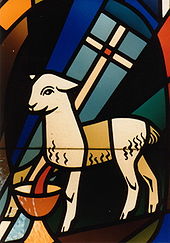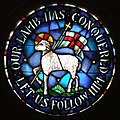Lamb of God
Christian doctrine holds that a divine Jesus chose to suffer crucifixion at Calvary to save the world from its sins. He was given up by divine Father, as an "agent and servant of God" in carrying away the sins of the world.[2][3] In Christian theology the Lamb of God is viewed as both foundational and integral to the message of Christianity.[4][5]
A lion-like lamb that rises to deliver victory after being slain appears several times in the
The Lamb of God title is widely used in Christian prayers. The Latin version,
also forms a part of the musical setting for the Mass.As a visual motif the lamb has been most often represented since the Middle Ages as a standing haloed lamb with a foreleg cocked "holding" a pennant with a red cross on a white ground, though many other ways of representing it have been used.
Gospel of John

Book of Revelation
The Book of Revelation includes over twenty-nine references to a lion-like lamb ("slain but standing") which delivers victory in a manner reminiscent of the resurrected Christ.[6] In the first appearance of the lamb in Revelation (5:1–7) only the lamb (which is of the tribe of Judah, and the root of David) is found worthy to take the judgment scroll from God and break the seals.[6] The reference to the lamb in Revelation 5:6 relates it to the Seven Spirits of God which first appear in Revelation 1:4 and are associated with Jesus who holds them along with seven stars.[13]
In Rev. 19:6-9, the lamb is said to be having a
In Revelation 21:14 the lamb is said to have twelve apostles.[6] The handing of the scroll (i.e. the book containing the names of those who will be saved) to the risen lamb signifies the change in the role of the lamb. In Calvary, the lamb submitted to the will of the Father to be slain, but now is trusted with the judgment of mankind.[17]
From the outset, the book of Revelation is presented as a "revelation of Jesus Christ" and hence the focus on the lamb as both redeemer and judge presents the dual role of Jesus: he redeems man through self-sacrifice, yet calls man to account on the day of judgment.[18]
Christology
The concept of the Lamb of God fits well within
The theme of a
In modern

Multiple hypotheses about the suitable symbolism for the Lamb of God have been offered, within various Christological frameworks, ranging from the interpretation of Old Testament references to those of the Book of Revelation.
In modern Roman Catholic Christology,
Liturgy and music
In the
Agnus Dei has been set to music by many composers, usually as part of a Mass setting.[29][30]
Art


In

In
The Moravian Church uses an Agnus Dei as their seal with the surrounding inscription Vicit agnus noster, eum sequamur ("Our Lamb has conquered, let us follow him").
Although the depiction of Jesus as the Lamb of God is of ancient origin, it is not used in the liturgical

Lamb of God is also part of Easter decorations.[32]
Heraldry

A paschal lamb is a charge used in heraldry, for example as the
Catholic sacramental
In the
Gallery
-
TheCatholic Monarchsinitials.
-
Theseal of the Moravian Church, the Agnus Dei window with the Lamb of God carrying the vexillum
-
Brass Agnus Dei from altar-front in theCathedral of the Assumption in Louisville, Kentucky
-
Agnus Dei on the 1311 coin of King Philip IV of France
-
Seven Seals
-
Stained glass Lamb of God carrying the vexillum, Royal Military College of Canada
-
Modern copy of a Romanesque Agnus Dei, Santiago de Compostela, Galicia
-
The Agnus Dei on Perth, Scotland's coat of arms holds the Scottish flag.
-
13th century depiction of a seven-eyed lamb
-
The Agnus Dei on the coat of arms of the Roman Catholic Diocese of Chengdu
-
Behold the lamb of God by Alexandre Bida
-
Lamb of God in church of Santiago inCoruña, Galicia, Spain
-
The Lamb of God in the coat of arms of Grasse, France.
See also
- Binding of Isaac
- Jesus in Christianity
- Lion of Judah
- Suffering servant
References
Citations
- ^ a b c Bulgakov 2008, p. 263.
- ^ a b c d Deme 2003, pp. 199–200.
- ^ a b Cullmann 1959, p. 79.
- ^ Gerlach 1998, p. 22.
- ^ Hoffmann 2005, p. 117.
- ^ a b c d Glabach 2007.
- ^ Chrysostom 1889.
- ^ Linman 2010, p. 148.
- ^ Marshall 1989, p. 369.
- ^ Redford 2007, pp. 100–101.
- ^ Pollard 2005, p. 21.
- ^ Hengel 2004, p. 371.
- ^ Schreiner 2008, p. 502.
- ^ Revelation 19:6–9
- ^ Shulman, Shlomo (n.d.). "Guide to the Jewish Wedding". aish.com. Retrieved 14 October 2021.
- ^ Hirsch, Emil G.; Kohler, Kaufmann; Schechter, Solomon; Broydé, Isaac (n.d.). "Leviathan and Behemoth". jewishencyclopedia.com. Retrieved 14 October 2021.
- ^ DeHaan 1998, p. 103.
- ^ Witherington 2003, p. 27.
- ^ Sadananda 2004, p. 281.
- ^ Weinrich & Oden 2005, p. 73.
- ^ a b Old 1998, p. 125.
- ^ a b Edmondson 2004, p. 91.
- ^ Bulgakov 2008, p. 129.
- ^ a b Neville 2001, p. 13.
- ^ Köstenberger et al. 2012, p. 114.
- ^ Rahner 1975, p. 74.
- ^ Henry 1907.
- ^ Lieuwen, Reader Daniel (n.d.). "Lives of Orthodox Western Saints". orthodox.net. McKinney TX – via St Nicholas Orthodox Church.
- ^ Randel 2003, p. 28.
- ^ Atkinson 1975, p. 14.
- ^ OCLC 1055176997.
- ^ Kowalczyk, Maria (2020). "Geneza i obchód Wielkanocy w Polsce. Zarys problematyki" (PDF). Studia Elbląskie (in Polish). XX: 273–294.
- ^ Montague-Smith 1968, p. 232.
- ^ Thurston 1907.
Sources
- Atkinson, C.M. (1975). The Earliest Settings of the Agnus Dei and Its Tropes. University of North Carolina at Chapel Hill.
- ISBN 978-0-8028-2779-1.
- Cullmann, O. (1959). The Christology of the New Testament. The New Testament library. Presbyterian Publishing Corporation. ISBN 978-0-664-24351-7.
- Chrysostom, John (1889). "Homily 15 on First Corinthians". In Philip Schaff (ed.). Nicene and Post-Nicene Fathers, First Series. Vol. 12. Translated by Talbot W. Chambers. Buffalo, NY: Christian Literature Publishing Co. – via New Advent.
- DeHaan, M. R. (1998). Studies in Revelation. Grand Rapids, MI: Kregel Publications. OCLC 39256374.
- Deme, Daniel (2003). The Christology of Anselm of Canterbury. Aldershot, Hampshire, England Burlington, VT: Ashgate. OCLC 51855472.
- Edmondson, Stephen (2004). Calvin's Christology. Cambridge New York: Cambridge University Press. OCLC 70891446.
- Gerlach, Karl (1998). The Antenicene Pascha: A Rhetorical History. Peeters. ISBN 9789042905702.
- Glabach, Wilfried (2007). Reclaiming the book of Revelation : a suggestion of new readings in the local church. New York: Peter Lang. OCLC 77333939.
- Hengel, M. (2004). Studies in Early Christology. Academic Paperback Series. Bloomsbury Academic. ISBN 978-0-567-04280-4.
- Henry, Hugh Thomas (1907). . In Herbermann, Charles (ed.). Catholic Encyclopedia. Vol. 1. New York: Robert Appleton Company.
- Hoffmann, Matthias Reinhard (2005). The Destroyer and the Lamb: The Relationship Between Angelomorphic and Lamb Christology in the Book of Revelation. Mohr Siebeck. p. 117. ISBN 3-16-148778-8.
- Köstenberger, A.J.; Kellum, L.S.; Quarles, C.L.; Quarles, C.L. (2012). The Lion and the Lamb: New Testament Essentials from the Cradle, the Cross, and the Crown. B&H Publishing Group. ISBN 978-1-4336-7708-3.
- Marshall, Paul (1989). Prayer book parallels : the public services of the church arranged for comparative study. New York: Church Hymnal Corp. OCLC 20641209.
- Linman, Jonathan (2010). Holy conversation : spirituality for worship. Minneapolis, MN: Fortress Press. OCLC 840417015.
- Montague-Smith, P.W., ed. (1968). Debrett's Peerage, Baronetage, Knightage and Companionage. Kingston-upon-Thames: Kelly's Directories.
- Neville, Robert (2001). Symbols of Jesus : a Christology of symbolic engagement. Cambridge: University Press. OCLC 46866407.
- OCLC 37392859.
- Pollard, T. E. (2005). Johannine Christology and the early Church. Cambridge New York: Cambridge University Press. OCLC 60320185.
- ISBN 978-0-86012-006-3.
- Randel, D.M., ed. (2003). The Harvard Dictionary of Music: Fourth Edition. Harvard University Press reference library. Harvard University Press. ISBN 978-0-674-01163-2.
- Redford, Doug (2007). The life and ministry of Jesus : the Gospels. Cincinnati, OH: Standard Pub. OCLC 71350394.
- Sadananda, D.R. (2004). The Johannine Exegesis of God: An Exploration Into the Johannine Understanding of God. Beihefte. Walter de Gruyter. ISBN 978-3-11-018248-4.
- ISBN 978-0-8010-2680-5.
- Thurston, Herbert (1907). . In Herbermann, Charles (ed.). Catholic Encyclopedia. Vol. 1. New York: Robert Appleton Company.
- Weinrich, W.C.; Oden, T.C. (2005). Revelation. Ancient Christian Commentary on Scripture. InterVarsity Press. ISBN 978-0-8308-1497-8.
- Witherington, Ben (2003). Revelation. Cambridge, U.K. New York: Cambridge University Press. OCLC 51223519.
External links
 Media related to Agnus Dei at Wikimedia Commons
Media related to Agnus Dei at Wikimedia Commons














